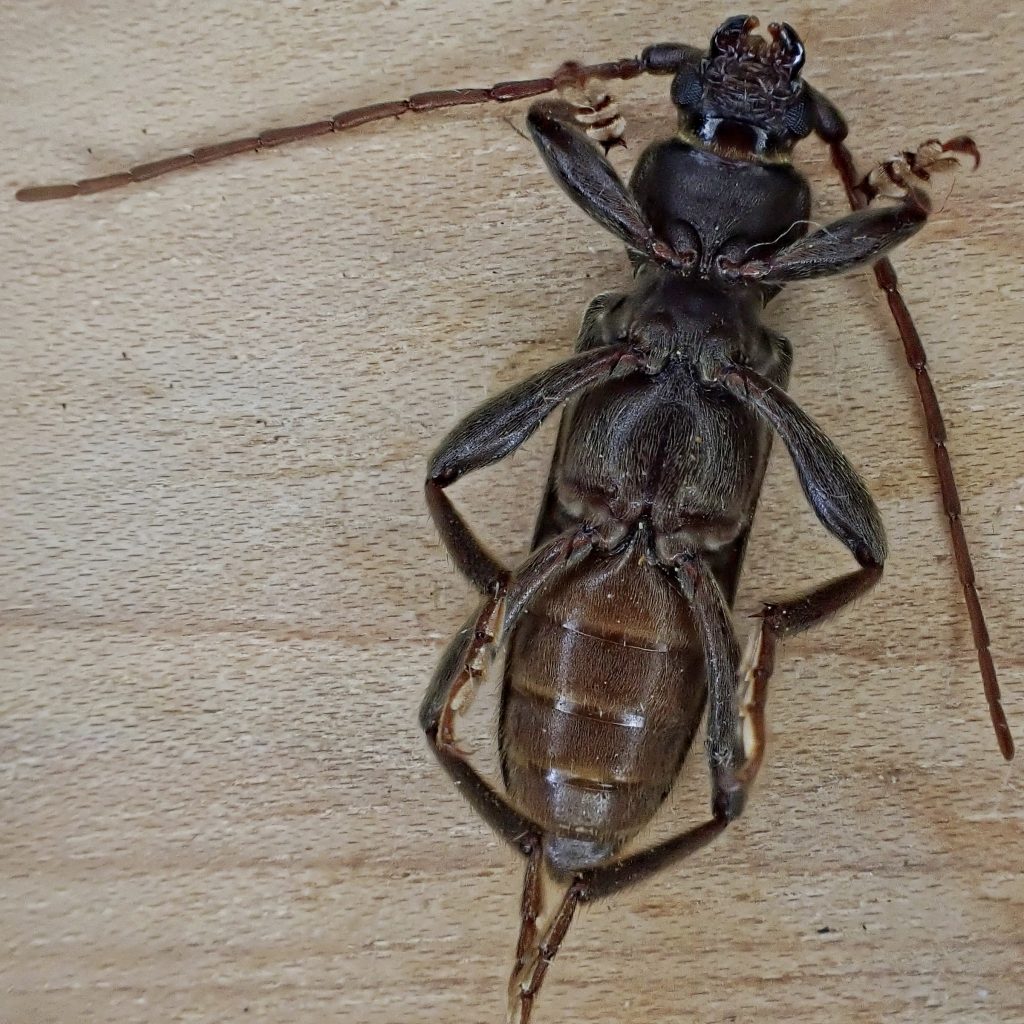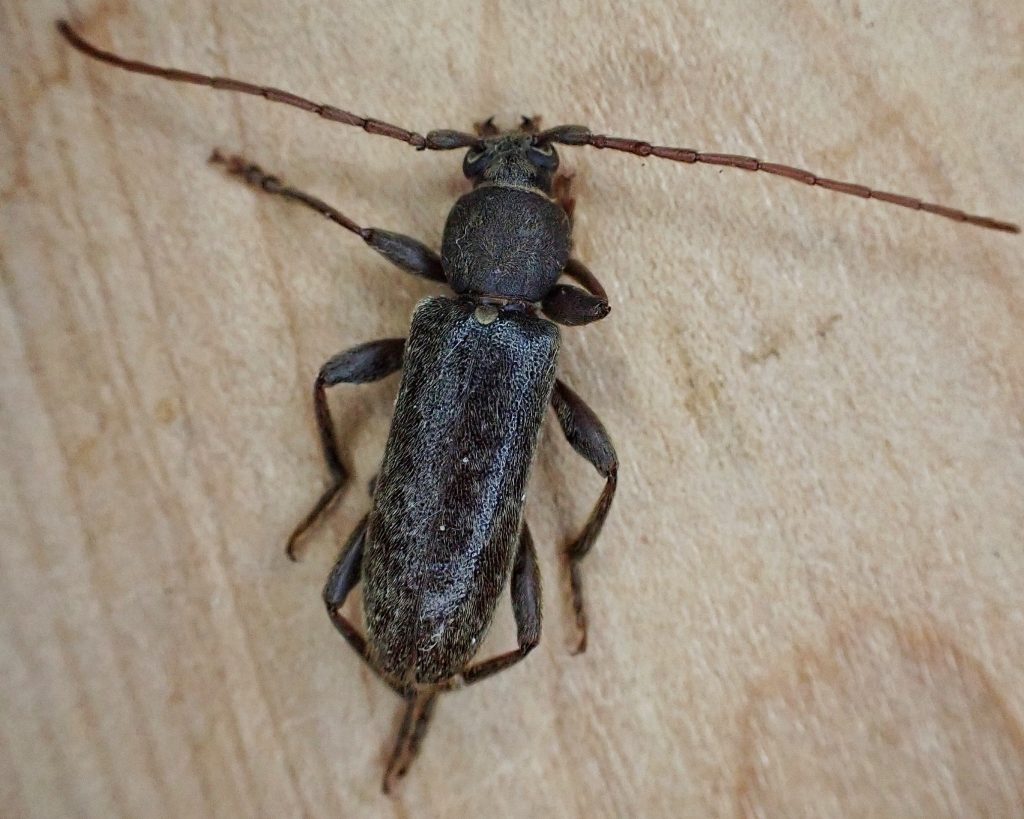
This is one of the beetles that visited my lights during the 3rd Night of Moth Week . Although it was nondescript, it was also rather interesting looking, with an oddly smooth and rounded pronotum, so I collected it. And I’m really glad I did! After it had chilled out overnight I took a bunch of photos, and then started trying to figure out what it was. I began with the Clytus/Neoclytus/Xylotrechus longhorns, but nothing went click. And neither did anything else in the longhorn section of ‘PNW Insects’. And I couldn’t find anything that looked right in Evans’ “Beetles of Western North America” either, so I tried plugging it into my Seek app, and it popped out Trichoferus campestris. That seemed way too easy, but there were definitely no Trichoferus in either of my go-to books, so I went to BugGuide, where I found images that looked right, but nothing from Washington state. So I posted it there, not really expecting anything, and went on to discover that this is a serious Eurasian pest beetle that was first found in North America in Montreal, Quebec in 2002, and was first found in the US in Rhode Island in 2006. It has since spread to at least 14 states and provinces.

I also found information that convinced me, even before the BugGuide experts confirmed my identification, that this was indeed Trichoferus campestris, which apparently hadn’t previously been found in the state of Washington. In fact it isn’t even listed on the Washington Invasive Species Council app, which made it difficult to report. I had to list it under ‘unknown insect’, which apparently meant that it got shunted off into some netherworld, because I’ve yet to hear back from them. And these are bad news bugs, for a couple reasons. The biggest problem with them is that, unlike almost all of our native longhorn beetles, the velvet longhorn beetles attack healthy, living trees as readily as diseased or dying ones. And they are known to attack over 40 different species! Which means not only is their habitat almost unlimited so that there are very few checks on their population expansion, but they could be anywhere and are therefore very difficult to control. I’d also like to note how much we can learn about an organism if we put the money into it. Just check out the ‘Eats’ and ‘Eaten by’ and ‘Life Cycle’ sections below, and compare that voluminous information to the dearth thereof for the Tragosoma harrisii that I posted yesterday.

Description– “Adults are 16 mm (3/4 in) long, parallel-sided, not shiny, and uniformly brownish black (Grebennikov et al., 2010) to orange-brown, with legs and antennae that are lighter colored than the rest of the body (Spears and Ramirez, 2014). Antennae are shorter than the body: slightly so in males and significantly so in females. The entire body is covered densely with short, uniform hairs and sparsely with long, erect hairs. The dorsal side of the thorax has fine lines (Fig. 1, 2; Grebennikov et al., 2010).” http://download.ceris.purdue.edu/file/3869

Similar species– “The only similar non-target in North America is a member of the Trichoferus-Hesperophanes complex, Hesperophanes pubescens. This species is difficult to separate from T. campestris. One source (Grebennikov et al. 2018) states that T. campestris has long erect setae protruding above the pubescence that are absent in H. pubescens. However, we have found that these hairs can be present OR absent in H. pubescens. Usually, differences in coloration and scutellum shape can separate the two: T. campestris is generally a darker brown- black (Fig. 8), with a scutellum that is about as wide as it is long with a very slightly tapered posterior margin (Fig. 10), while H. pubescens is lighter in color (Fig. 9), with a scutellum that is wider than long and with a more widely rounded posterior margin (Fig. 11).” http://download.ceris.purdue.edu/file/3730

Habitat– “Trichoferus campestris lives in forests and orchards, as well as in wood piles, wood packaging material, rustic furniture, and other wooden structures (Iwata and Yamada, 1990). T. campestris adults are active at night and each female lays approximately 50 eggs in her lifetime (Xinming and Miao, 1998) on tree trunks or branches or on the bark of dry logs (Iwata and Yamada, 1990; Rodman et al., 2019). In China, adults have been observed to fly for short distances and survive for 15-20 days (Xinming and Miao, 1998).” http://download.ceris.purdue.edu/file/3869
Range– Native to northern Eurasia; has been found in North America in e Canada, ne, midwest, and western US; in our region it has been found in Boise, Idaho, Medford and Astoria, Oregon, and Vancouver, Washington, and possibly other locations.

Eats– “Preferred living hosts; Malus spp. (apple)*, Morus spp. (mulberry)*, Prunus avium (sweet cherry)*, and Prunus persica(peach)* (Jiangsu Mulberry Pests Survey Group, 1997; Ray et al., 2019; Zhang et al., 2017). Other living hosts; Acer platanoides (Norway maple)*, Astragalus membranaceus (membranous milk- vetch), Betula utilis (Himalayan birch), Cunninghamia lanceolata (Chinese fir)*, Fraxinus velutina (velvet ash)*, Juglans spp. (walnut)*, Larix sibirica (Siberian larch), Malus pumila (paradise apple)*, Paeonia lactiflora (Chinese peony)*, Picea obovata (Siberian spruce), Picea crassifolia (Qinghai spruce), Pinus sibirica (Siberian pine), Pinus spp. (pine)*, Populus spp. (aspen, cottonwood, poplar)*, Prunus armeniaca (apricot)*, Prunus pseudocerasus (Chinese sour cherry), Quercus spp. (oak)*, Quercus variabilis (Chinese cork oak), Salix spp. (willow)*, Sorbus aucuparia (European mountain ash, rowan)*, Styphnolobium japonicum (Japanese pagoda tree)*, Syzygium aromaticum (clove), Ulmus pumila (Siberian elm)*, Ulmus spp. (elm)*, and Ziziphus jujuba (jujube)* (Bullas-Appleton et al., 2014; Cao et al., 2012; Cao et al., 2014; Dong and Guo, 2018; Gui et al., 2016; Guo and Yin, 2005; Jiang and Zhang, 1996; Kadyrov et al., 2016; Lei et al., 2017; Li et al., 2009; Lin, 2014; Makhnovskii, 1966; Rehemaidula, 2013; Shen and Tang, 1987; Zhang et al., 2017; Zou et al., 2018). Dry wood hosts; Alnus spp. (alder)*, Betula spp. (birch)*, Chamaecyparis obtusa (hinoki false cypress), Diospyros spp. (persimmon, ebony)*, Fagus crenata (Japanese beech), Glycyrrhiza uralensis (Chinese licorice), Juglans mandshurica (Manchurian walnut), Juglans regia (walnut)*, Morus australis(Korean mulberry), Pinus densiflora (Japanese red pine), Quercus spp. (oak)*, Robinia pseudoacacia (black locust)*, Rubus idaeus (raspberry)*, Zelkova serrata (Japanese zelkova)*, and Vitis vinifera (grape)* (Bai and Zhang, 1999; Hegyessy and Kutasi, 2010; Iwata and Yamada, 1990; Sama et al., 2005; Wang et al., 1988). Wood products of uncertain origin; Dunnage, solid wood packaging material, and home goods such as trays and rustic log furniture (Allen and Humble, 2002; Haack, 2006; Hodgetts et al., 2016; MDA, 2016; Wu et al., 2017).” http://download.ceris.purdue.edu/file/3869
Eaten by– “Predators include flat bark beetles, cylindrical bark beetles, clerid beetles, click beetles, robber flies, assassin and ambush bugs, thrips, carpenter ants, birds, lizards, spiders, scorpions, toads, and small mammals. Parasitoids include braconid, ichneumonid, and chalcid wasps; and tachinid and sarcophagid flies. Nematodes and fungi have been observed as pathogens of other species of longhorned beetle larvae (Smith 1999). At this time, however, management of VLB is not reliant on biological control.” Utah Pests fact sheet for Trichoferus campestris.

Adults active– “Peak flight and mating occur from June to early August in Utah (Rodman et al., 2019) and from late June to mid-August in New York (Francese, 2019). In one study in Utah, sentinel traps caught the first adults on June 14th (Ray et al., 2019). In Canada (Grebennikov et al., 2010) and in its native range in Russia (Švácha and Danilevsky, 1987), adults emerge from July to August, although we found no studies that looked at factors influencing the phenology of the beetle.” http://download.ceris.purdue.edu/file/3869
Life cycle- “Eggs hatch after 10 days, and larvae burrow shallowly beneath the bark to form tunnels between the phloem and xylem (Xinming and Miao, 1998). As larvae mature, they may burrow deeper into the tree. In most cases, early instar larvae need bark to survive (Dockray and Nadel, 2016; Iwata and Yamada, 1990), but once they enter deeper into the wood, the bark is no longer necessary. This explains how T. campestris can develop and emerge from debarked wood packaging materials (Wu et al., 2017) and finished wooden products (MDA, 2016). Larvae pupate within the tree in late winter, either shallowly beneath the bark or within a pupal chamber. They remain inside the tree throughout the winter and emerge as adults in early summer (Fig. 3). They can take as long as two years to complete development (Rodman et al., 2019).” http://download.ceris.purdue.edu/file/3869

Etymology of names– Trichoferus may be a combination of the Greek word for ‘hair’ and the Latin word for ‘wild/untamed’, although the Latin word might be a corruption of ‘rusty’, but whether it is ‘wild haired’ or ‘rusty haired’, or something else altogether, Wollaston did not deign to tell us to what he is referring. The specific epithet campestris is from the Latin word for ‘relating to a plain/growing in a field’, but I cannot ascertain what Falderman was referencing.

Species Trichoferus campestris – Velvet Longhorned Beetle – BugGuide.Net
https://www.zin.ru/Animalia/Coleoptera/addpages/grebenn/trichofe.pdf
https://portal.ct.gov/-/media/CAES/CAPS/Trichoferus-campestris-Fact-Sheet.pdf
http://download.ceris.purdue.edu/file/3869
http://download.ceris.purdue.edu/file/3730
https://en.wikipedia.org/wiki/Trichoferus_campestris

Great work!
Thanks so much for what you do.
~ Brooke
Thanks for your appreciation, Brooke!
Just found one of these on our porch in Utah. Around it were several various sized other beetles. There’s a bird nest (sparrow maybe) that has been up on our porch ceiling almost all summer and the amount of poop those cute birds drop is astounding. Could the beetles be attracted to it? We haven’t had the heart to destroy the best even with how nasty the mess is. We have trees in our neighborhood, but just very young ones and not very many. How do we get rid of the beetles? Could pest control people help? Great research. Thank you.
I’d be surprised if the beetles were attracted to the nest, Jenna. Probably just to the light. I’d talk to your local extension agent about how to get rid of the VLBs. The other beetles are probably beneficial.